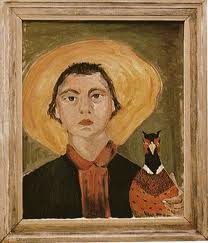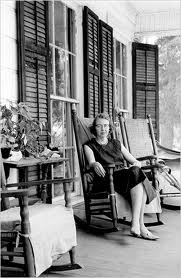Flannery O’Connor was an oddball–a Catholic living in the Bible Belt, so it is no wonder her stories revolve around eccentrics, misfits, and a slew of bizarre characters usually typified as the grotesque in Southern literature. She had that sympathetic vision of their plight, for she was a displaced person in that culture not only because of her religion but also because she suffered from a disability. Thus in “Good Country People” she writes of the one-legged, college-educated girl Hulga, who gave herself that ugly name on purpose, living alone with her mother,” or the retardedgirl married off to the itinerant carpenter in “The Life You Save May Be Your Own.” O’Connor observed the onion in the petunia patch and loved it even though it did not look or smell as lovely as a flower. Reading her fiction, I wondered how her Catholic sensibilities could coexist with the Bible-thumping, literalness of the Southern Baptist Church. You can’t be a Catholic and not love metaphor and symbol–the staples of O’Connor’s vision.
In her essays and letters she explains that she wrote about Protestants from a Catholic perspective. Her fiction is laden with Catholic iconography and Biblical allusions to affirm that even the dim-witted, the halt, the lame, the most malicious and despicable, are not impervious to revelation or divine grace. According to the Catholic catechism from which she would have been taught, “God made man to know Him, to love Him, and to serve Him in this world, and to be happy with Him forever in heaven.” Even the deformed and the violent serve that purpose in some fashion. The freak in the carnival in her story “The Temple of the Holy Ghost” tells the sideshow crowd, “God made me thisaway and if you laugh He may strike you the same way. This is the way He wanted me to be and I ain’t disputing His way.” In another place in her letters, she says that the South is “Christ-haunted” while acknowledging that quality also in herself. She actually called herself a “hillbilly Thomist,” but I prefer to term her a hillbilly Catholic. Her letters are often hilarious. Sometimes she directs the humor at herself, adopting the rural idiom that she knew so well to pose as a country bumpkin.
She perceived that religious fervor borders on violence and is capable of overflowing into overt violence–an idea she explores in her novel The Violent Bear It Away–the title taken from Matthew 11:12. This is a world of fundamentalism, of religious fanatics and charlatans, which she also informs her first novel Wise Blood. While poking fun at the absurdities of her characters, she at the same time validates their search for God with her particular Catholic mystical vision that a soul must descend into the depths of darkness–the Dark Night of the Soul–in order to receive a spiritual rebirth. This is not the same as the one time Protestant declaration of accepting Jesus Christ as one’s personal savior, but is a long journey into night. Consequently the motifs of light and blindness play prominently in O’Connor’s imagery.
Catholic characters figure in two of her short stories, both less widely anthologized. In “The Temple of the Holy Ghost” two girls from a convent school dubbed themselves, “Temple One” and “Temple Two,” making fun of the nun’s counsel against boys’ sexual advances. In one of her most humorous scenes, O’Connor has the two girls matched with two Protestant country boys, aspiring Church of God preachers, who strum church hymns for them. In response the two girls sing the traditional Latin chant “Tanto Ergo” for the boys. This is a very funny story about the immaturity of religion based on dogma and not yet forged in the fiery furnace of suffering and pain. In “The Displaced Person” Southern culture is illuminated when a Polish family from a displaced person’s camp in the post-War World II period come to work on a widow’s farm. They are placed there through the efforts of an elderly Irish Catholic priest. The Guizacs are obviously Catholic. Mr. Guizac is so hard-working that the white farm hands fear the foreigners will displace both them and the black workers. Although the widow claims to have no religion, she ultimately faces a moral dilemma. The priest tells the widow, “Christ was just another D.P.” There is more than one displaced person in the story other than Mr. Guizac. Here the intricate relations among poor whites, Negroes, white landowners, and foreign newcomers are portrayed with wit and irony, exploding in tragedy at the end. The one person whose place is not disrupted is the old priest. If I had to pick one story of O’Connor’s to anthologize without consideration of its length, it would be this one.
This hillbilly Catholic’s perspective superbly captured the place she inhabited and by rendering it so well she created a universal vision of mankind’s dilemma wherever they may live. The South inhabited by freaks, eccentrics and fanatics replicates one facet of American culture. No matter how grotesque or dark the picture, there lurks in the background the potential for redemption. No matter what the region of the world a man inhabits, he innately possesses a thirst for spiritual truth. According to O’Connor, even the path of nihilism must lead to God. For the origin of my last statement, read Wise Blood. But any of her stories and novels will make for great discussion because they are so dense and provocative.

